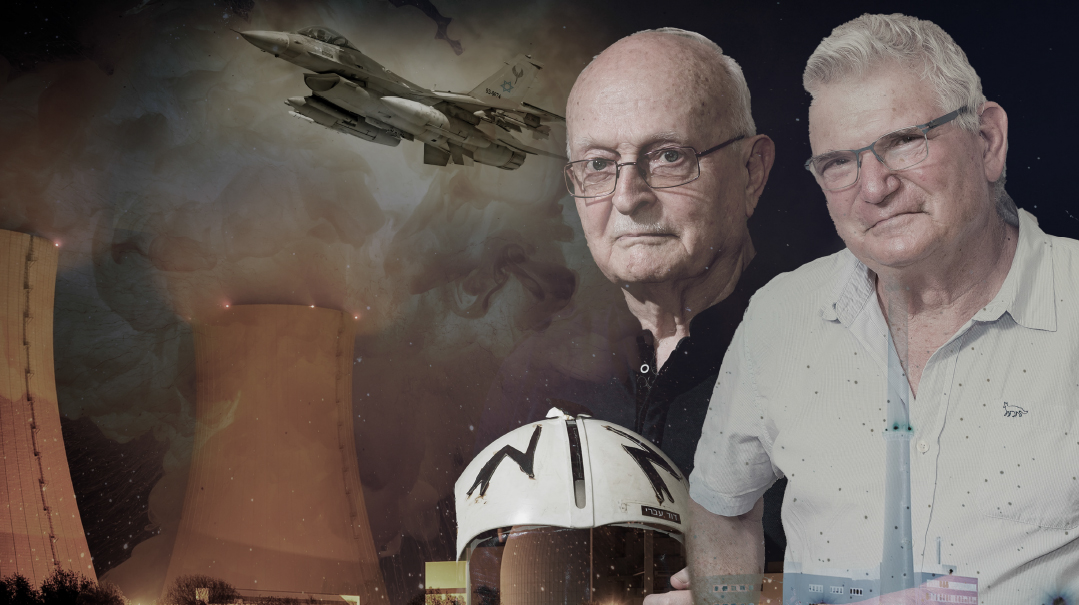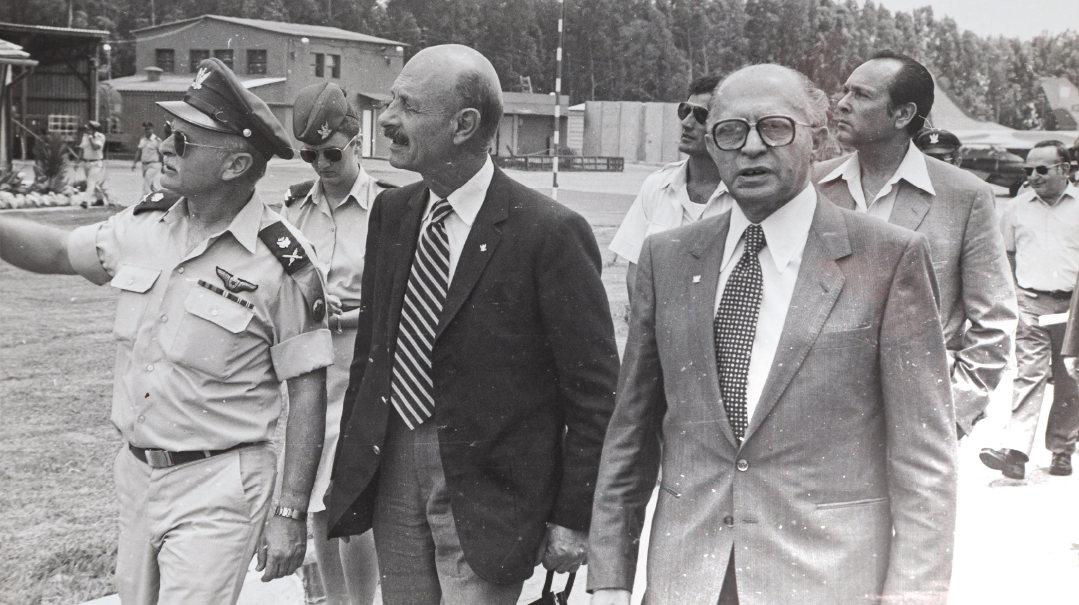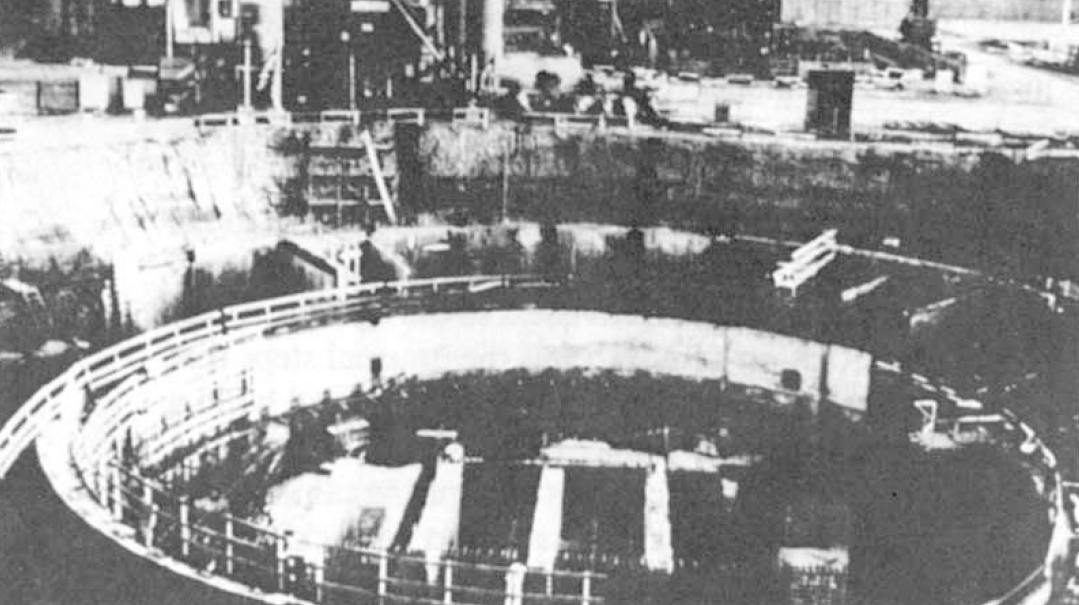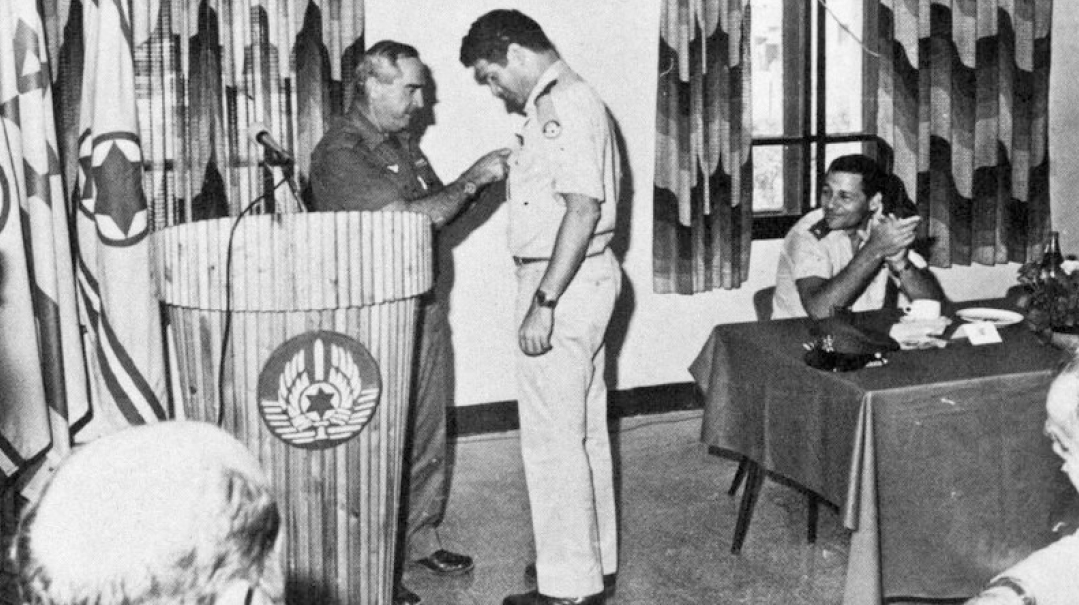Under the Radar
| July 6, 2021Forty years later, Israeli fighters trace the daring bombing of Iraq's nuclear reactor

Photos: Elchanan Kotler, AP images, GPO
King Hussein of Jordan was spending Sunday, June 7, 1981, lounging with his family on his royal yacht in the Gulf of Aqaba, when he noticed something unusual in the sky. A fleet of low-flying Israeli F-16 fighter jets sped overhead in the direction of Saudi Arabia and the Persian Gulf. Hussein tensed. He asked one of his advisors to connect him to the Jordanian army’s command center, pronto.
While the king reported what he had just seen, the generals on the other end of the line listened intently. The military alert level was raised, Jordan’s technological capabilities were put into overdrive, but a few moments later, the king received an update that Jordan’s airspace had not been violated, and there did not seem to be any infiltration of aircraft to its territory. Hussein apparently tried to alert his neighboring Arab monarchs about those suspicious warplanes heading for their lands, but the communications systems on his yacht seemed to be scrambled. At least he knew his territory was safe.
Later, the world was stunned when Operation Opera was disclosed: Israeli fighter planes had flown over Iraq undetected and destroyed Saddam Hussein’s Osirak nuclear reactor.
Four years earlier, when Israel discovered that France was providing parts for Iraq to build a plutonium reactor that could be used to make nuclear weapons, the Jewish state knew the clock was ticking. By 1981, Israel had to work quickly: Intelligence sources indicated that by the end of June, the reactor — located 11 miles south of Baghdad — would have nuclear weapon production capabilities, and destroying an operational reactor at that stage would be a radioactive regional nightmare. While no one in the international intelligence community had foreseen that Israel would muster the courage — or the technical capacity — to carry out such an operation, Prime Minister Menachem Begin knew the window of attack was just a matter of days, and so he gave the green light.
Forty years after the operation that stunned the world — at first garnering the expected international condemnation but later praised as a heroic mission that stabilized the region against nuclear destruction — retired Maj. Gen. David Ivry, the IAF commander at the time, and Col. (Ret.) Zev Raz, leader of the mission, reconstruct the pivotal decision that removed the nuclear threat from Israel, and in retrospect, turned out to be crucial not only for Israel but for the entire Middle East.
While the reactor was known as Osirak, the name given by the French suppliers, the Iraqis called it by another name: “17 Tammuz.” They weren’t consciously thinking about the date that Nevuchadnezar breached the walls of Jerusalem and began the final stage of the churban of the First Bais Hamikdash; rather, it corresponds to the date and month on the Iraqi calendar that the Iraqi Baath party rose to power in 1968. (Still, Saddam Hussein, the Iraqi despot who directed the construction of the reactor, considered Nevuchadnezar one of the national patriarchs of Iraq, and aspired to follow in his ways.)

Menachem Begin had to make a daring decision that would probably incur the wrath of the world. In consultation with military top-brass and IAF commander David Ivri (L), it was time to strike
Out of Time
Ivri remembers the consultations that led up to the daring decision. “I was summoned for a discussion at the defense department, where they presented documents signed three years earlier between France and Iraq to build an atomic reactor ‘for peaceful purposes.’ The French claimed that they would be able to oversee activity, but our experts posited that the reactor was advanced enough that the Iraqis would be able to make a nuclear bomb within two years, so the timetable was very tight.”
The State of Israel faced a dilemma. In contrast to the public way the Iranian threat is being handled today, back then knowledge about the operation of the Iraqi reactor was a top-tier military secret — and no one could predict the reaction of Saddam Hussein, known as a bloodthirsty madman who was already then in the crosshairs of the West.
The first step, before considering a military incursion, was the intelligence angle — and nothing, it seemed, was too complex for the Mossad, which sprang into action. According to new revelations, Mossad operatives, aided by scientists who had worked at the reactor, were able to craft diagrams and maps accurately documenting the structures and the labs that operated in the reactor zone. Through intercepted conversations and faxes between France and Iraq, the Mossad learned many secrets, and with the help of Iranian spies, they were able to get accurate aerial photos.
Initially, technicians, engineers, scientists and managers of French, Italian and other companies received appeals, and some explicit threats, recommending that they not help the regime of Saddam Hussein. In the end, though, there were just a few resignations — not enough to slow the pace of construction.
At this point, Prime Minister Begin instructed Mossad chief Yitzchak Chofi to move to the next stage and to block the supply chain for the reactor. The Mossad focused on supply shipments originating in France. In the middle of 1979, one of the spy organization’s most daring operations was carried out in Toulon, France. CMIM, a company that produced parts for the reactor, had a large warehouse located on the outskirts of the city, and late one spring night, 15 Mossad agents, under the command of legendary operative Mike Harari, infiltrated the compound. A few of the agents engaged the guards, while the others penetrated the factory and attached bombs with delay timers.
A short time later, a number of powerful explosions shook the sleepy city. The next morning, French newspaper offices received anonymous calls from someone identifying himself as a member of a militant French anti-nuclear organization, taking responsibility for the attack. While France’s intelligence services suspected that it was a Mossad operation, they chose to play the ecology game.
While these stealth operations didn’t stop Iraq’s nuclear program, they did delay the completion of the reactor’s construction by two years: the end date for the project was adjusted from1979 to June 1981. During those two years, neighboring enemy Iran targeted the reactor at least twice, but was only able to inflict cosmetic damage. And so, the discussions in Israel’s security establishment were moved to the front burner.

The unfinished Osirak reactor, “The Iraqis would be able to make a nuclear bomb within two years, so the timetable was very tight”
Jet-Setters
It was the Israel Air Force that was tasked with preparing a strike plan, says Ivri, since a ground operation was too risky. But the main problem was that the planes it had at the time couldn’t make the round-trip to Iraq — nearly 1,000 miles away — and back without refueling. And refueling over hostile Arab nations was certainly no option. But then, Israel had a stroke of good fortune.
The Islamic Revolution led by Ayatollah Khomeini overthrew Mohammad Reza Pahlavi, the Shah of Iran and a staunch US ally, leading the US to cancel a massive deal to supply Iran with 75 state-of-the-art F-16 fighter jets.
Instead, the Americans offered them to Israel.
“I conferred with defense minister Ezer Weizmann and immediately said yes,” says Ivri. “When you’re offered the best fighter jets, first you say yes, then you figure out how you’ll use them. Still, there were lots of things to worry about. First of all, there was the technology issue. We would be launching a complex and dangerous operation without being intimately familiar with the plane’s systems. The second problem was the fuel. The plan involved flying round trip without refueling, and the fuel capability of the F-16s was borderline for the operation. Still, when the political echelons gave their approval, we decided to go for it.”
According to Zev Raz, “The fact that the jets came to us because of the Iranian revolution is one of the greatest ironies in history.”
When Menachem Begin presented the plan to the cabinet however, not everyone agreed. Several top officials, including defense minister Ezer Weizmann, was opposed, while Begin’s biggest support came from Ariel Sharon. While the government was debating, the Air Force began their preparations. Ivri says that the reactor itself was an easier target than a home in a crowded Gaza or Beirut neighborhood, but the biggest problem was reaching their destination without refueling mid-journey.
Ivri estimated that Iraqi receptors would pick up the approaching jets fifteen minutes before the attack. For that reason, the eight F-16 bombers were to be shadowed by an “aerial umbrella,” another six F-15 jets that would deflect any Iraqi fire until the mission’s completion.
Ivri selected eight top Israeli pilots for the operation: Zev Raz (who led the attack and was later decorated by the Chief of Staff for his leadership), Yiftach Spector, Amos Yadlin (who later became chief of Military Intelligence), Dovi Yaffe, Amir Nachumi, Chagai Katz, Yisrael (Relik) Shafir, and Ilan Ramon. All the pilots were Yom Kippur War veterans except for Ramon, the youngest of the group. He was included because of his expertise in preparing the maps and figuring out the optimal conditions for the least amount of fuel. Ramon later became an Israeli hero in his own right, as the first Israeli astronaut in space, perishing in the Columbia space shuttle disaster in 2003.
According to mission leader Raz, Ramon had played such a vital role in planning the raid and configuring the fuel use that he couldn’t conscionably exclude him, even though there were more experienced pilots clamoring to be part of the attack, and even though Ramon had never dropped a bomb in enemy territory before.
The preparations took about half a year of training, and the pilots themselves were given only the barest details. “The pilots didn’t understand why we were training at such a low altitude, and doing the same exercises over and over. It was very different from their regular training routines. Only a few days before the operation did we share with them the details of the mission,” says Ivri.
After much deliberation, it was decided: the operation would take place Sunday, 5 Sivan, June 7 — Erev Shavuos. Sunday was chosen because that was the French technicians’ day off, and Israel didn’t want to harm them. Still, the choice of day triggered surprise in the senior IDF ranks. “We never conduct training between Erev Chag until after Yom Tov,” says Raz, “and if foreign intelligence picked anything up, they’d know it was unusual activity.” But considering all the factors and realizing every day was one day closer to an Iraqi bomb, the decision was made.
Chief of Staff Rafael “Raful” Eitan gave the crew their final briefing. “He told us, ‘Anyone who falls into captivity should tell the Iraqis everything he knows. What you know is nothing. It’s important to me that you return safe and sound.’ It was clear to me that he was speaking as a bereaved father, and not as a tough commander. This wasn’t the hardened Raful.”
Then Raful opened up a package of dates and passed them around, and gave each pilot a wad of Iraqi dinars should their planes be shot down. Shafir and Ramon were the last in the formation, and Shafir later said in an interview that both he and Ramon were sure they’d be shot down because they were at the tail. But that didn’t deter them from the mission they knew they had to do. “Every time you embark on a mission, you tell yourself that you might get killed today,” he said, “but once you close the cockpit, you bury all those feelings and forebodings and just go on autopilot.”

Squadron leader Zev Raz presented with a medal of honor by Raful Eitan. Fear wasn’t in the equation
Chasing the Sun
On Sunday, Erev Shavuos at 4:01 p.m., the fourteen aircraft took off, in radio silence, and at low altitude (300 feet) to evade radar detection. Before that, they had carried out an unusual and risky “hot refueling” — topping off the fuel tanks while the engines of the planes were already active.
“I approved it, despite the risk, because of the very tight fuel situation,” says Ivri.
The planes swallowed up the thousand miles to Iraq in just an hour and a half. On the way, they dropped the emptied detachable fuel tanks over the Saudi Arabian desert, in order to lighten the weight of the aircraft.
At 5:26, two sets of four F-16s ascended to an altitude of 10,000 feet and dropped bombs weighing a total of 16 tons over the reactor. Half of the bombs exploded on contact with the dome of the reactor — which was clearly visible and totally uncamouflaged — and the rest had a delay that would make them explode only after they’d penetrated deep into the reactor itself. Just 56 seconds later, the Tammuz I reactor was completely destroyed and the planes turned around, heading home.
Ten Iraqi soldiers and one French civilian, an engineer and employee of a French governmental agency, were killed in the attack. Afterward, Israel agreed to pay restitution to the engineer’s family.
But right after the first explosion, the Israelis knew it wouldn’t be long until the Iraqis got wind of the plot, and there was a risk of anti-aircraft fire.
“Well, we had trained for this possibility, but in the end we didn’t have to deal with any significant fire against us,” says Raz. “I was leading the formation, and I can’t tell you how the tension relaxed once I realized there was no significant return fire.”
That’s because the artillery installations protecting the reactor opened fire only after the attack. For fifteen minutes, the cannons continued firing indiscriminately into the air. Iraqi Air Force jets rose to the air to pursue the bombers, but eventually turned back.
“Three hours after takeoff, we were already back at the base, but we were chasing the sun. It reminded me of the story in Sefer Yehoshua, when the sun stood still in Givon until the battle was over.”
Pray for Us
Once the planes took off, Menachem Begin apprised several cabinet members individually of the operation, but they weren’t the only ones to know. MK Shlomo Yaakov Gross of Agudah, who at the time served on the Knesset defense committee, made an emergency Erev Yom Tov visit to the Vizhnitzer Rebbe, informing him that a major military operation was taking place. The Rebbe responded, “I already know …” meaning, he knew and he was davening for its success.
In addition, a close talmid of Rav Shach reported that someone from the military visited the Rosh Yeshivah the previous night, Motzaei Shabbos, and asked him to daven for a successful outcome.
It was also known that Rebbe Mordechai of Lelov had his aide telephone Begin before the attack to convey his blessings for success.
While the rest of the country was oblivious, two family members were privy to the operation: the wife and mother of pilot Dovi Yaffe. Yaffe decided to tell his wife Michal about the planned attack, telling her, “If you see my body hanging in a city square in Baghdad, I want you to know which operation I was sent on. So that you shouldn’t have a sudden shock.”
He didn’t have to tell his mother. She served as Begin’s stenographer, she had registered all the protocols, she knew which squadron would be involved, and knew that her son Dovi would take part.
The other pilots’ families were spared the anxiety and fear.
“We were told that the State of Israel would not admit to the operation, so we were really surprised when, the following day, Menachem Begin convened a press conference and publicly discussed it,” remembers Zev Raz. “It was amusing, because just after the news broke I had taken a hitch with a soldier and I saw that he was very excited. He said to me, ‘Did you hear the news? Our government announced that they bombed Iraq’s atomic reactor!’ I came home and told my family, ‘Well, if the news is out already… I did it.’”
Didn’t his family sense his fear? A foreboding of danger or even death? Despite the heavy responsibility he carried, Raz relates that fear wasn’t in the equation.
“I didn’t let it occupy my thoughts,” he says. “When a person is in the lead, his feelings are very different. Imagine someone’s little sister is under attack. Will the older brother succumb to his fear? No. He can’t give in to his fear, because he’s responsible for his little sister. The one time I was afraid on a flight was during the Yom Kippur War, and it was a flight I was not commanding. That’s how it is with fear.
“During Operation Tammuz, the only thing I could focus on was finding the target,” Raz continues. “It’s like the story of the hunter who’s about to die and wonders who he should give all his hunting tools to. He calls his sons and addresses the oldest. ‘What do you see?’ he asks. ‘I see you, and my two brothers.’ He asks the second: ‘What do you see?’ And the son replies, ‘I see you, my two brothers and a tree.’ Then he asks the youngest son, ‘What do you see?’ And he answers: ‘I see a bird on the tree.’ The hunter gave him the bow and arrow.”
Caught Off Guard
There were those who accused Begin of electioneering by choosing to reveal the Israeli strike just three weeks before an election, and contrary to an IDF Intelligence recommendation that Israel would be safer if the world would attribute the attack to Iran. But Begin proudly defended his decision to spare his people from a nuclear holocaust, saying, “What are we, thieves in the night?”
Opposition leader Shimon Peres even went as far as accusing Begin of using the operation as a political ploy. Begin responded to Peres’s accusation at a Likud rally: “Jews, you have known me for forty years… Would I send Jewish boys to risk death — or captivity worse than death, because those barbarians would have tortured our boys horribly — for an election?” In the end, Likud was reelected over Peres’s Alignment party by one seat.
The pilots, for their part, accepted the public’s praise, but have stated over the years that the true hero was Begin, who ordered the attack knowing he was risking the wrath of a hostile Middle East and world condemnation.
The US government was caught completely off-guard by the attack, and this failure was perceived as a grave blunder within the US intelligence community. In fact, in testimonies during Jonathan Pollard’s various hearings, it was mentioned that the information Pollard passed on to Israel — information vital to Israel’s security — was withheld by the US as a “punishment” for Israel’s bombing of the Iraqi nuclear reactor. According to senior intelligence sources, America at the time had hopes of turning Saddam Hussein into a pillar of American foreign policy in the Middle East, and when the Israelis foiled that, they were furious.
But a decade later, by the beginning of the Gulf War, Saddam Hussein became the undisputed enemy of the West, and Begin was unilaterally vindicated. The strike became known as the “Begin Doctrine,” a preemptive strategy that Israel continues to employ.
And what about today? Does Israel have the capacity to inflict similar damage on Iran’s nuclear facilities, which, once they’re up and running, will pose a direct and lethal threat to Israel?
“Iran is a totally different story,” says Raz. “The Iranians are clever and have learned the lessons of the Tammuz operation. Their facilities are hidden — they have centrifuges all over the country, most of them underground. We’d need an international coalition to send in the military, get to all the tunnels, and destroy the centrifuges. It’s not something you can resolve with one brave air force mission.”
David Ivri, who was involved in various security operations under Binyamin Netanyahu, takes a different tack. “No one can totally remove the nuclear threat,” he says. “By destroying the reactor in Iraq we gained a few years, and it’s the same with Iran: It’s impossible to entirely remove the threat — it can only be delayed.”
But as someone who’s been privy to operations in both countries, he has one enduring piece of advice: “When it comes to the whole nuclear issue, there’s one golden rule — to speak as little as possible. You have to keep doing, but you also have to keep quiet.”
(Originally featured in Mishpacha, Issue 868)
Oops! We could not locate your form.







